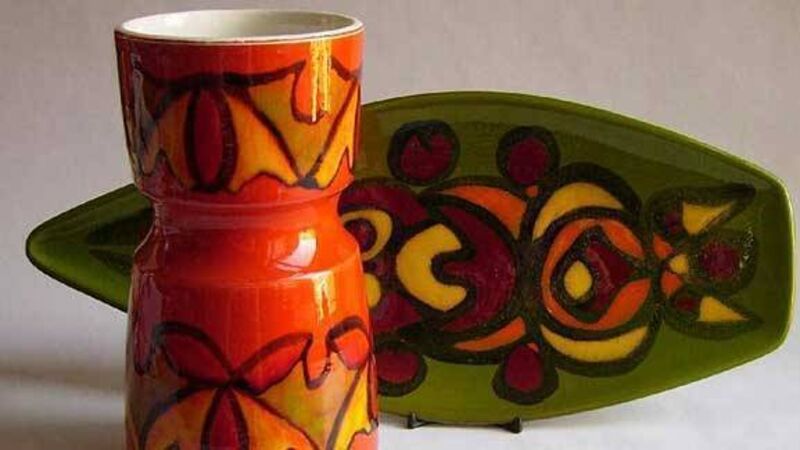Vintage view: Poole Pottery

There are many areas of vintage Poole Pottery, but let’s look at two, one produced in the 1950s and the other first championed in the 1970s. Both reflect huge changes in popular interiors, and that’s what we are looking for in collectables — things that reflect the character of the times.
Poole’s genesis as a potting company in the 1940s was the firm Carter Stabler Adams, a group formed as manufacturer of architectural ceramics some 20 years before. Some of their original tiles can still be seen on the walls of the London Underground. The original company operated from 1873-2006, the factory taking its name from its original home on Poole quayside only in 1963.
Poole always had artistic leanings, and was influenced by the iconic Bloomsbury group of artists and intellectuals working after WWI.
Poole was known through the 30s and 40s for its popular Streamline and flowery Traditional tableware introduced by talented company wives Truda Adams (Carter) and Phoebe Stabler. Certainly Art Deco and modern for their time, some collectors prefer these feminine hand-painted wares and they continued to be up to 1981. With a change of creative guard in the 1950s, Poole alerted the British design world with new avant-garde patterns and forms under the direction of lamp designer Alfred Burgess Read, many of the shapes emerging from the hands of head-thrower Guy Sydenham.
Read’s Contemporary range was strongly inspired by the popular Scandinavian ceramics of the time and featured bands of colour and bold dynamic over-painting in rhythmical geometric strands, hypnotic lines and repeated organic forms. Much of the restrained colour was dreamed up by chief painter Ruth Pavely and set on a quiet Alpine White glaze.
From 1956 to 1962, the Freeform collection including the now iconic Ravioli, Stars and Tadpole patterns proved a big hit with war shaken homemakers keen to replace the twee 19th century surroundings celebrated by their Victorian parents. Pieces from this mid-century period of Poole are highly sought after in perfect condition as they sit well in the retro inspired simplicity of most homes.
Larger feature pots command high prices. Together with the back-stamp, look for three letter descriptions for waisted, round and signature ‘peanut’ shaped vases, including PRP, PLC and PKT. It is often possible to determine the painter of a piece by their individual mark, and every piece is hand thrown and hand painted, so no two pieces of Poole are identical. The leaping dolphin mark appeared on Poole pots in the 1958, when a division of the factory presented itself firmly as studio pottery maker, offering pieces to be admired, collected and set firmly at the centre of British art and design.
Chief designer Tony Jefferson and Guy Sydenham, encouraged artists to bring something completely new and personal to the work. Like a fountain of psychedelic lava, the spray on orange, yellow, green and orange glazes with startling abstract designs in carved and thrown pots, were launched under the names Delphis. With positive results, Delphis was followed by the wildly successful Aegean, and Atlantis.
1970s Poole is something of a Marmite, you either love it or will run screaming from its audacious, loud, scrafitto presence. If late 50s Poole is Simon and Garfunkel, Delphis is full on Rolling Stones.
Some of the greater pieces are dubbed loftily, as Ionian.
In contrast to the muddy taupe décor contemporary with their production, 70s Poole presents as glorious ceramic artwork when placed on a spare white wall.
Car boot sales, auctions and house clearances still produce pieces of formerly derided 1970s vessels, trays and chargers, and less expensive tableware. Keep your eyes open for a flash of marmalade or amber green in a mixed box of goods. Limited edition stoneware figures of animals also date from this period.
Poole was restarted as a brand a year after its artistic demise and eventual closure, re-opening a studio to the public at Poole in 2007.
The pieces are now made in Burslem, Staffordshire. Their ‘living’ glazes react chemically as they touch off each other, igniting into fabulous effects. Feverishly collected in new shapes and designs gleaned from the groovy originals of the 60s and 70s, their current master potter Alan White’s work is known throughout the world.
Watch out for new limited editions of Poole from designers/paintresses Jane Brewer, Nicky Massarella and Lorna Whitmarsh.
Collectors clubs for old and new abound www.poolepottery.co.uk
Try www.poolepotterycollectorsclub.net and www.antique-marks.com for identifying marks for your vintage pieces.













